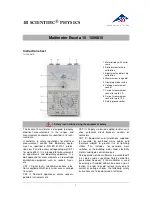
EU-Konformitätserklärung
EC DECLARATION OF CONFORMITY
DÉCLARATION „CE“ DE CONFORMITE
DECLARATION DE CONFORMIDAD UE
Wir erklären in alleiniger Verantwortung, dass die Bauart des:
We declare that the following designated product:
Nous déclarons sous propre responsabilité que ce produit:
Declaramos bajo nuestra sola responsabilidad que este producto:
Digital Multimeter (Art. 32220L)
Digital Multimeter
Multimètre numériques Digital
Multimetro Digital
folgenden einschlägigen Bestimmungen entspricht:
complies with the requirements of the:
est en conformité avec les réglementations ci-dessous:
esta conforme a las normas:
LVD Council Directive 2006/95/EC
EMC Council Directive 2004/108/EC
Angewandte Normen:
Identifi cation of regulations / standards:
Norme appliquée:
Normas aplicadas:
EN 61010-1-2010
EN 61010-2-033:2012
EN 61010-031:2002+A1:2008
EN 61326-1:2006
EN 61326-2-2:2006
Verifi cation No.: EC.1282.OA130313.ZWE0318/ DT830B
Test Report: CTL130301263-S
Remscheid, den 16.01.2014
Heiner Tilly (Geschäftsführer)
SW-Stahl GmbH · Leverkuser Straße 65 · 42897 Remscheid / Germany
GB
Digital Multimeter
Operator’s Manual
READ THIS MANUAL BEFORE USE!
INTRODUCTION
WARNING
To avoid electric shock or personal injury, read “Safety Information” and
“Warning and Precautions” before using the Meter.
SAFETY INFORMATION
This Meter complies with the standards EN61010-1: in pollution degree 2,
overvoltage category (CAT II 600V) and double insulation.
International symbols used on the Meter and in this manual are in Table1.
Table 1. International Electrical Symbols
AC (Alternating Current)
.
DC (Direct Current)
.
AC or DC
Battery
Safety information. Refer to the manual
.
Dangerous voltage may be present
.
Earth ground
.
Fuse
.
Conforms to European Union directive
.
Double insulated
.
Use the Meter only as specifi ed in this manual, otherwise the protection provided
by the Meter may be impaired.
In this manual, a Warning identifi es conditions and actions that pose hazards
to the user.
A Caution identifi es conditions and actions that may damage the Meter or the
equipment under test.
WARNING AND PRECAUTIONS
To avoid possible electric shock or personal injury, and to avoid possible damage
to the meter or to the equipment under test, comply with the follow practices:
Do not use the meter if it is damaged. Before you use the meter, inspect the
case. Pay particular attention to the insulation surrounding the connectors.
Inspect the test leads for damaged insulation or exposed metal. Check the test
leads for continuity. Replace damaged test leads before you use the meter.
Do not use the meter if it operates abnormally. Protection may be impaired.
When in doubt, have the meter serviced.
Do not operate the meter around explosive gas, vapor, or dust.
Do not apply more than the rated voltage, as marked on the meter, between
terminals or between any terminal and earth ground.
Before use, verify the meter’s operation by measuring a known voltage.
When measuring current, turn off circuit power before connecting the meter
in the circuit.
When servicing the meter, use only specifi ed replacement parts. Do not use
the Meter in a manner not specifi ed by this manual, or the safety features of
the Meter may be impaired.
Use with caution when working above 30V ac rms, 42V peak, or 60V dc. Such
voltages pose a shock hazard.
When using the probes, keep your fi ngers behind the fi nger guards on the
probes.
Connect the common test lead before you connect the live test lead. When you
disconnect test leads, disconnect the live test lead fi rst.
Remove the test leads from the meter before you open the battery door.
Do not operate the meter with the battery door or portions of the cover
removed or loosened.
To avoid false readings, which could lead to possible electric shock or personal
injury, replace the batteries as soon as the low battery indicator (“
”) appears.
Safety Compliance: EN61010-1, 2000 CAT II 600V overvoltage standards. Do
not measure voltages above 600V in Category II installations..
Overvoltage installation categories per EN61010-1, 2000: The Meter is designed
to protect against transients in these categories:
CAT I From high-voltage low-energy sources, e.g., electronic circuits or a copy
machine.
CAT II From equipment supplied from the fi xed installation, e.g., TVs, PCs,
portable tools and household appliances.
CAT III From equipment in fi xed equipment installations, e.g., installation panels,
feeders and short branch circuits, and lighting systems in large buildings.
GENERAL SPECIFICATIONS
Maximum Voltage between any Terminal and Earth Ground: 600V
Measurement rate: updates 2-3/sec.
Over range indication: “1” fi gure only in the display
Automatic negative polarity indication.
The “
” is displayed when the battery voltage drops below the operating
voltage.
Operating temperature: 10°C~40°C, 0~75% R.H.
Storage temperature: -10°C~50°C, 0~75% R.H.
Power: 2 X 1.5V AAA battery
Dimensions: 126L*70W*24Hmm.
Weight: approx 140g (including battery)
FRONT PANEL DESCRIPTION
1. DISPLAY
3 ½ digit, 7 segment, 0.5” high LCD.
2. FUNCTION AND RANGE SWITCH
This switch is used to select the function and desired range as well as to turn
on the instrument. To extend the life of this battery, the switch should be in the
“OFF” position when the instrument is not in use.
3. “10A” JACK
Plug in connector to red (positive) test lead for 10A measurement.
4. “VΩmA” JACK
Plug in connector for red (Positive) test lead for all voltage and resistance and
current (except 10A) measurements.
5. “Common” JACK
Plug in connector for black (negative) test lead.
SPECIFICATIONS
DC VOLTAGE
DC CURRENT
Range
Resolution
Accurcy
Range
Resolution
Accurcy
200 mV
100 μV
±(0,5% +3Digit)
200 μA
100 nA
±(1,8% +2Digit)
2000 mV
1 mV
±(1,0% +5Digit)
2000 μA
1 μA
20 V
10 mV
20 mA
10 μA
200 V
100 mV
200 mA
100 μA
±(2,0% +2Digit)
600 V
1 V
±(1,2% +5Digit)
10 A
10 mA
±(2,0% +10Digit)
OVERLOAD PROTECTION:
220V rms AC for 200mV range and
600V DC or 600V rms for all ranges.
OVERLOAD PROTECTION:
0.5A/600V and 10A/600V fuse
MEASURING VOLTAGE DROP: 200mV
AC VOLTAGE
RESISTANCE
Range
Resolution
Accurcy
Range
Resolution
Accurcy
200 V
10 mV
±(0,5% +10Digit)
200 Ω
0,1 mΩ
±(1,0% +10Digit)
600 V
1 V
2000 Ω
1 Ω
±(2,0% +4Digit)
RESPONSE: Average responding,
calibrated in rms of a sine wave.
FREQUENCY RANGE: 45Hz ~ 450Hz
OVERLOAD PROTECTION: 600V DC
or 600V rms for all ranges.
20 kΩ
10 Ω
200 kΩ
100 Ω
2000 kΩ
1 kΩ
MAXIMUM OPEN CIRCUIT VOLTAGE: 3.0V.
OVERLOAD PROTECTION:
15 seconds maximum 220Vrms.
OPERATING INSTRUCTIONS
WARNING
To avoid electric shock hazard and/or damage to the instrument, do not
measure voltages that might exceed 600V above earth ground.
Before the use of instrument, inspect test leads, connectors and probes
for cracks, breaks, or crazes in the insulation.
Dangerous voltages may be present at the input terminals and may not
be displayed.
To avoid electric shock or damage to the Meter when measuring
resistance or continuity in a circuit, make sure the power to the circuit
is turned off and all capacitors are discharged.
DC & AC VOLTAGE MEASUREMENT
1. Connect red test lead to “VΩmA” jack, Black lead to “COM” jack.
2. Set RANGE switch to desired VOLTAGE position, if the voltage to be measured
is not known beforehand, set switch to the highest range and reduce it until
satisfactory reading is obtained.
3. Connect test leads to device or circuit being measured.
4. Turn on power of the device or circuit being measured voltage value will
appear on Digital Display along with the voltage polarity.
DC CURRENT MEASUREMENT
1. Red lead to “VΩmA”, Black lead to “COM” (for measurements between 200mA
and 10A, connect red lead to “10A” jack with fully depressed.)
2. RANGE switch to desired A
position.
3. Open the circuit to be measured, and connect test leads INSERIES with the
load in with current is to measure.
4. Read current value on Digital Display.
5. Additionally, “10A” function is designed for intermittent use only. Maximum
contact time of the test leads with the circuit is 10 seconds, with 15 minutes
intermission time between tests.
RESISTANCE MEASUREMENT
1. Red lead to “VΩmA”. Black lead to “COM”.
2. RANGE switch to desired “Ω” position.
3. If the resistance being measured is connected to a circuit, turn off power and
discharge all capacitors before measurement.
4. Connect test leads to circuit being measured.
5. Read resistance value on Digital Display.
6. At 200Ω range, shorten test lead, one certain digit will be shown on LCD. This
resistance is caused by internal resistance of tested electric circuit (including
fuse resistance). So when measuring resistance, please deduct the result by
this certain digit.
DIODE MEASUREMENT
1. Red lead to “VΩmA”, Black lead to “COM”.
2. RANGE switch to “
” position.
3. Connect the red test lead to the anode of the diode to be measured and black
test lead to cathode.
4. The forward voltage drop in mV will be displayed. If the diode is reversed,
fi gure “1” will be shown.
TRANSISTOR hFE MEASUREMENT
1. RANGE switch to the hFE position, plug the multi-function socket to the COM
and “VΩmA” ternimal.
2. Determine whether the transistor is PNP of NPN type and locate the Emitter,
Base and Collector leads. Insert the leads into the proper holes of the Socket.
3. The meter will display the approximate hFE value at the condition of base
current 10μA and V
CE
2.8V.
MAINTENANCE
Beyond replacing batteries and fuses, do not attempt to repair or service your
Meter unless you are qualifi ed to do so and have the relevant calibration,
performance test, and service instructions. The recommended calibration
cycle is 12 months.
Periodically wipe the case with a damp cloth and mild detergent. Do not use
abrasives or solvents.
Dirt or moisture in the terminals can affect readings.
To clean the terminals
a) Switch the Meter OFF and remove the test leads.
b) Shake out any dirt that may be in the terminals.
c) Soak a new swab with isopropyl alcohol and work around the inside of each
input terminal.
d) Use a new swab to apply a light coat of fi ne machine oil to the inside of each
terminal.
TEST LEADS REPLACEMENT
Warning:
Full in compliance with safety standards can be guaranteed only if used
with test leads supplied. If necessary, they must be replaced with the same model
or same electric ratings. Electric ratings of the test leads: 600V/10A. You must
replace the test leads if the lead is exposed.
The measurement category of a combination of the test leads and an
accessory is the lower of the measurement categories of the test leads and
of the accessory.
The test leads intended for use within measurement category I, shall not to use
the test leads for measurements within the other measurement categories
TESTING THE FUSES
WARNING
To avoid electric shock or injury, remove the test leads and any input
signals before replacing the fuses.
1. Turn the rotary switch to 200mA position.
2. Use a multimeter to measure resistance of VΩmA terminal or 10A terminal to
COM terminal.
A good mA terminal or 10A terminal fuse is indicated by a reading between
0Ω and 10Ω.
If the display is overloaded, replace the fuse and test again.
If the display shows any other value, have the meter serviced.
3. Please replace fuse as below:
Fuse1: F10A/600VH
Fuse2: F0.5A/600VH
EN61010-1
CAT II 500V
max. 10A
32220L
RoHS
D I G I TA L- M U LT I M E T E R
B E D I E N U N G S A N L E I T U N G
3 2 2 2 0 L
S W- S TA H L G M B H
•
An der Hasenjagd 3
D-42897 Remscheid
•
www.swstahl.de
1
2
3
4
5




















